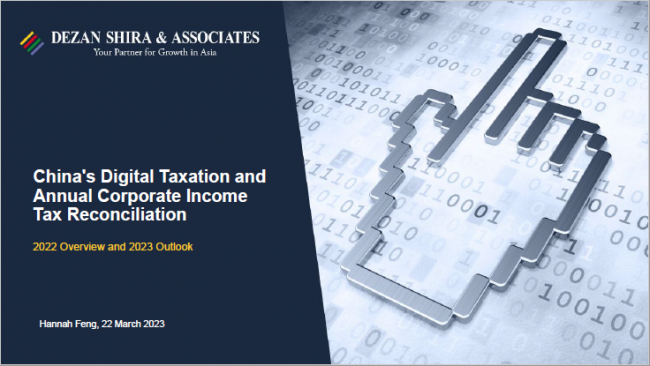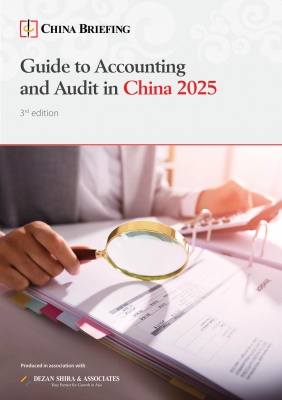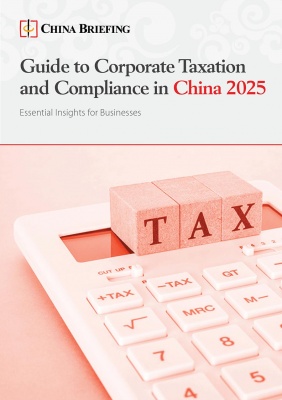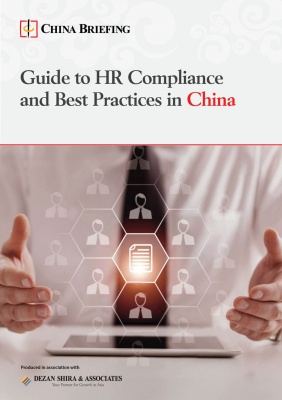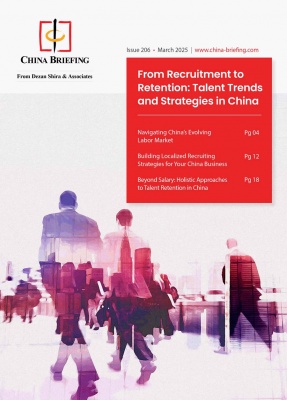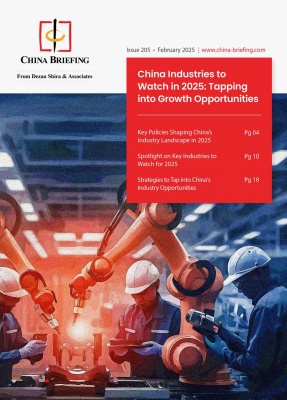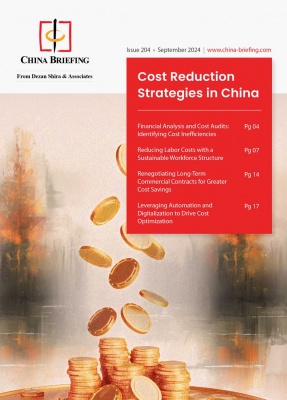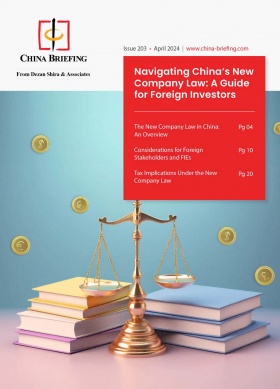A Guide to Minimum Wages in China (As of April 7, 2025)
The minimum wages in China continue to rise. We offer a guide to minimum wages in the Chinese Mainland and discuss how labor costs are affected by changes to the minimum wage levels.
The minimum wages in China continue to rise.
As of April 7, 2025, Shanghai has the highest monthly minimum wage among 31 provinces (RMB 2,690/US$370 per month), and Beijing has the highest hourly minimum wage (RMB 26.4/US$3.7 per hour).
28 regions – Anhui, Beijing, Chongqing, Fujian, Gansu, Guangdong (including Shenzhen), Hainan, Hebei, Heilongjiang, Henan, Hubei, Hunan, Jiangsu, Jiangxi, Inner Mongolia, Jilin, Liaoning, Ningxia, Shaanxi, Shandong, Shanghai, Shanxi, Sichuan, Tianjin, Tibet, Xinjiang, Yunnan, and Zhejiang – have surpassed the RMB 2,000 (US$275) mark in their monthly minimum wage standards.
At the lower end of the wage spectrum, Guangxi has the lowest minimum wage level (RMB 1,690 per month).
In 2024, 16 provinces, including Henan, Jiangsu, Zhejiang, Hubei, Ningxia, Jiangxi, Heilongjiang, Hunan, Yunnan, Jilin, Inner Mongolia, Liaoning, Tianjin, Gansu, Hainan, and Guangxi, raised their minimum wage levels.
Coming into 2025:
- The new minimum wage in Sichuan, Chongqing, Shanxi, and Xinjiang took effect on January 1.
- Guizhou’s new minimum wage standards came into effect on February 1.
- Guangdong’s new minimum wage standards will come into effect on March 1.
- Fujian’s new minimum wage standards will come into effect on April 1.
- Shandong, Hebei, and Tibet are also expected to see adjustments in 2025.
- On March 7, Guangxi issued a notice inviting public comments on its new minimum wage standard. According to the draft, the minimum wage standard for Category I regions is proposed to be adjusted to RMB 2200 per month.
What is the minimum wage in China?
According to China’s Provisions on Minimum Wage, the legal minimum wage refers to the minimum labor remunerations that shall be paid by the employers to the employees under the precondition that the employee has provided normal labor within the promissory working hours or within the working hours that is prescribed in the labor contracts.
The minimum wage standards are determined by provincial governments by taking into consideration factors, such as the minimum living costs of local employees and their dependents, the urban residents’ consumption price index, the social insurance premiums, and the housing funds paid by the employees themselves, the average salary of the employees, the level of local economic development, the local employment status, etc.
In general, the minimum wage standards appear in two forms, namely, the monthly minimum wage standard and the hourly minimum wage standard. The monthly minimum wage standard applies to full-time employees while the hourly minimum wage standard applies to non-fulltime employees, such as part-time and temporary employees.
To be noted, the minimum wage is just the basic wage that employers must pay their employees, which excludes overtime pay, night shift allowance, summer high-temperature allowance, the special working environment allowance, and subsidies for meals, transportation, and housing.
Nevertheless, China’s minimum wage standards do include the social insurance premiums and housing fund contributions paid by employees in most regions. In fact, it is possible that the employee’s take-home pay is lower than the corresponding minimum wage standard in these regions. Only a few regions, such as Shanghai, clearly stipulate in their local rules that their local minimum wage standards exclude social insurance premiums and housing fund contributions.
Local governments in China are generally required to update their minimum wages every few years but have the flexibility to adjust wages according to local conditions.
Most provinces set different classes of minimum wage levels for different areas, depending on the given region’s level of development and cost of living. For example, a higher minimum wage class is established for the provincial capital and the most developed cities in the province, whereas smaller cities and rural areas fall under a lower wage class.
The minimum wage in China guide
A complete guide to China’s minimum wages can be found below.
|
Minimum Wages in China 2025 |
|||||
| Province/region | Class | City/urban area* | Monthly minimum wage (RMB) | Hourly minimum wage (RMB) | Effective date |
| Anhui | A | Hefei | 2,060 | 21 | 2023.03.01 |
| B | Bengbu
Huaibei Huainan Xuancheng |
1,930 | 20 | ||
| C | Anqing
Fuyang Huangshan |
1,870 | 19 | ||
| D | Certain county-level cities | 1,780 | 18 | ||
| Beijing | – | – | 2,420 | 26.4 | 2023.09.01 |
| Chongqing | A | Certain suburban districts and counties | 2,330 | 23 | 2025.01.01 |
| B | Certain suburban districts and counties | 2,200 | 22 | ||
| Fujian | A | Xiamen | 2,265 | 23.5 | 2025.04.01 |
| B | Fuzhou
Quanzhou Pingtan FTZ |
2,195 | 23 | ||
| C | Zhangzhou
Ningde |
2,045 | 21.5 | ||
| D | Sanming
Nanping |
1,895 | 20 | ||
| Gansu | A | Lanzhou
Jiayuguan Yumen Dunhuang |
2,020 | 21 | 2023.11.01 |
| B | Hezuo | 1,960 | 20.5 | ||
| C | Linxia | 1,910 | 20 | ||
| D | Certain county-level cities | 1,850 | 19.5 | ||
| Guangdong | A | Guangzhou | 2,500 | 23.7 | 2025.04.01 |
| Shenzhen | 2,520 | ||||
| B | Zhuhai
Foshan Dongguan Zhongshan |
2,080 | 19.8 | ||
| C | Shantou
Huizhou Jiangmen Zhanjiang Zhaoqing |
1,850 | 18.3 | ||
| D | Other cities | 1,750 | 17.4 | ||
| Guangxi | A | Nanning
Liuzhou Guilin Wuzhou Beihai Fangchenggang Qinzhou |
1,990 | 20.1 | 2023.11.01 |
| B | Yulin
Baise Guigang |
1,840 | 18.6 | ||
| C | Certain county-level cities | 1,690 | 17 | ||
| Guizhou | A | Guiyang
Qingzhen Chishui |
2,130 | 22.4 | 2025.02.01 |
| B | Kaiyang | 1,980 | 20.8 | ||
| C | Xifeng
Xiuwen |
1,890 | 19.8 | ||
| Hainan | A | Haikou
Sanya Yangpu Economic Development Zone |
2,010 | 17.9 | 2023.12.01 |
| B | Qionghai
Danzhou Sansha |
1,850 | 16.3 | ||
| Hebei | A | Shijiazhuang
Baoding Langfang Tangshan Qinghuangdao Cangzhou Handan |
2,200 | 22 | 2023.01.01 |
| B | Xintai
Hengshui Zhangjiakou Chengde |
2,000 | 20 | ||
| C | Certain country-level cities | 1,800 | 18 | ||
| Heilongjiang | A | Harbin (except certain districts)
Daqin |
2,080 | 19 | 2024.05.01 |
| B | Qiqihar
Mudanjiang Jiamusi Suihua |
1,850 | 17 | ||
| C | Heihe
Yinchun Daxinganling |
1,750 | 16.5 | ||
| Henan | A | Zhengzhou
Luoyang Anyang |
2,100 | 20.6 | 2024.01.01 |
| B | Kaifeng
Puyang Nanyang |
2,000 | 19.6 | ||
| C | Weihui | 1,800 | 17.6 | ||
| Hubei | A | Wuhan | 2,210 | 22 | 2024.02.01 |
| B | Huangshi
Yichang Huanggang Tianmen |
1,950 | 19.5 | ||
| C | Certain county-level cities | 1,800 | 18 | ||
| Hunan*** | A | Changsha
Zhuzhou |
2,100 | 21 | 2024.09.01 |
| B | Xiangtan
Yueyang Changde |
1,900 | 19 | ||
| C | Zhangjiajie
Yongzhou Yiyang |
1,700 | 17 | ||
| Inner Mongolia | A | Hohhot
Erenhot |
2,270 | 22.4 | 2024.12.01 |
| B | Hulunbuir
Xilinhot |
2,200 | 21.7 | ||
| C | Bayanur
Ulanhot |
2,140 | 21.1 | ||
| Jiangsu | A | Nanjing
Suzhou Zhenjiang Changzhou Wuxi |
2,490 | 24 | 2024.01.01 |
| B | Yangzhou
Nantong Lianyungang |
2,260 | 22 | ||
| C | Suqian | 2,010 | 20 | ||
| Jiangxi | A | Nanchang | 2,000 | 20 | 2024.04.01 |
| B | Jiujiang
Shangrao Pingxiang Ji’an |
1,870 | 18.7 | ||
| C | Yichun
Fuzhou |
1,740 | 17.4 | ||
| Jilin | A | Changchun | 2,120 | 21 | 2024.10.01 |
| B | Jilin
Songyuan Songyuan Yanji Huichun |
1,920 | 19.5 | ||
| C | Siping
Tonghua Liaoyuan Baicheng urban area Meihekou City Other counties (cities) |
1,780 | 18 | ||
| Liaoning | A | Dalian
Shenyang |
2,100 | 21 | 2024.05.01 |
| B | Anshan
Dandong Fushun Yingkou |
1,900 | 19 | ||
| C | Chaoyang
Fuxin |
1,700 | 17 | ||
| Ningxia | A | Yinchuan
Shizuishan |
2,050 | 20 | 2024.03.01 |
| B | Lingwu
Wuzhong Zhongwei |
1,900 | 18 | ||
| Qinghai | – | – | 1,880 | 18 | 2023.02.01 |
| Shaanxi | A | Xi’an | 2,160 | 21 | 2023.05.01 |
| B | Baoji
Hancheng Hanzhong Tongchuan Weinan Xianyang Yan’an Yulin |
2,050 | 20 | ||
| C | Ankang
Shangluo |
1,950 | 19 | ||
| Shandong | A | Dongying
Jinan Qingdao Weifang Weihai Yantai Zibo |
2,200 | 22 | 2023.10.01 |
| B | Binzhou
Jinning Linyi Rizhao Tai’an Zaozhuang |
1,900 | 19 | ||
| C | Dezhou
Heze Liaocheng |
1,820 | 18 | ||
| Shanghai | – | – | 2,690 | 24 | 2023.07.01 |
| Shanxi | A | Most districts under Taiyuan; some districts and county-level cities under Datong, Changzhi, Jincheng, Shuozhou, Yizhou, Jinzhong, Linfen, Lvliang, and Yuncheng | 2,150 | 23.2 | 2025.01.01 |
| B | Most county-level cities under Datong, Changzhi, Shuozhou, Yizhou, Jinzhong, Linfen, and Yuncheng | 2,050 | 22.1 | ||
| C | Other county-level cities | 1,950 | 20.9 | ||
| Sichuan*** | A | Chengdu | 2,330 | 23 | 2025.01.01 |
| B | Certain districts under the jurisdiction of Chengdu | 2,200 | 22 | ||
| Tianjin | – | – | 2,320 | 24.4 | 2023.11.01 |
| Tibet | – | – | 2,100 | 20 | 2023.09.01 |
| Xinjiang | A | Karamay
Taxkorgan Tajik Autonomous Region |
2,070 | 20.7 | 2025.01.01 |
| B | Changji
Shixenze Urumqi Wujyachu |
1,890 | 18.9 | ||
| C | Aksu
Arai Kashgar Korla Kumul Tumxuk Turpan Wusu |
1,750 | 17.5 | ||
| Yunnan | A | Kunming | 2,070 | 20 | 2024.10.01 |
| B | Certain counties under the jurisdiction of Kunming | 1,920 | 19 | ||
| C | Other county-level cities | 1,770 | 18 | ||
| Zhejiang*** | A | Hangzhou
Ningbo Wenzhou |
2,490 | 24 | 2024.01.01 |
| B | Huzhou
Jinhua Shaoxing Taizhou |
2,260 | 22 | ||
| C | Lishui
Zhoushan |
2,010 | 20 | ||
Notes:
*Certain provinces set minimum wage standards at the county or district level. The cities listed in the table are examples and are not exhaustive.
**Highlighted areas denote jurisdictions that updated their minimum wage in 2025. The monthly minimum wage is for full-time employment, while the hourly minimum wage is for part-time employment.
*** Hunan, Zhejiang, and Sichuan provinces allow each city to decide which minimum wage level to apply. The cities given as examples are, therefore, subject to change.
What is affected by the minimum wage increase?
As the minimum wage rises, minimum standards for other employee benefits, such as overtime pay, other allowances, and subsidies, increase in kind.
Housing fund
The minimum contribution base of the housing fund in many cities is the same as the local minimum wage standards. The change in the minimum wage means the adjustment of the housing fund contribution base in the following months. The ceiling of the housing fund contribution base is usually three times the local average monthly salary of employees in the previous year, and the floor of the housing fund contribution base is usually the same as the local minimum wage standard.
To be noted, however, the adjustment of the housing fund contribution base is not always in sync with the change in the minimum wage standard. For example, to reduce labor costs and help struggling businesses survive in the wake of the COVID-19 pandemic, the Shanghai government decided that its minimum contribution base of the housing fund in 2021 would follow the 2020 minimum wage standard rather than the 2021 standard.
Companies are advised to pay attention to announcements from the local government.
Wages during the probation period
Article 20 of the Labor Contract Law stipulates that the wage amount of a worker during their probation period shall not be less than the lowest wage amount for the same job position in the employer’s organization or 80 percent of the wage amount agreed in the labor contract and shall not be less than the minimum wage standard of the locality of the employer.
Therefore, the wages paid by the enterprise to the probationary employees who are on regular attendance should not be lower than the corresponding standard amount.
Wages during sick leave
Different cities have different standards regarding sick leave payments. But, one universal rule is that the sick leave wage shall not be lower than 80 percent of the local minimum wage, according to the Opinions on Several Issues concerning the Implementation of the Labor Law of the People’s Republic of China (Lao Bu Fa [1995] No. 309).
Correspondingly, the minimum sick leave wage standard shall be adjusted with the increase of the local minimum wage standard.
Severance payment
Article 27 of the Implementation Regulations for the Labor Contract Law of the People’s Republic of China stipulates that the monthly salary used for calculating the severance payment to an employee shall be no less than the local minimum wage standard. If the average pay of the employee in the 12 months before the termination of the labor contract is less than the local minimum wage standard, the local minimum wage standard shall be used to calculate the severance payment.
Wages during the suspension of work or production
Companies may decide to suspend their businesses or production in the wake of internal or external difficulties, such as during lockdowns caused by the pandemic. According to relevant provisions on wage payment during the period of suspension of production:
- If the suspension period is within one wage payment cycle, salaries shall be paid according to the standards stipulated in the labor contract; and
- If the suspension period goes beyond one wage payment cycle, the living allowance shall be paid by the enterprise, and the living allowance shall be implemented in accordance with the relevant local regulations.
Referring to the regulations of Zhejiang Province, Hubei Province, and Shaanxi Province, the employer is required to pay a living allowance of 70~80 percent of the local minimum wage.
Wages of dispatched employees
According to Article 58 of the Labor Contract Law, during the period in which a dispatched worker is not assigned any work duties, the labor dispatch agency shall pay the worker remuneration on a monthly basis pursuant to the local minimum wage standard.
Wages of injured workers
Article 35 and Article 36 of the Regulations on Work-Related Injury Insurance stipulates that where a worker who sustained a work injury is certified grade 1 to grade 6 disability, he/she shall enjoy corresponding benefits, such as a one-off disability subsidy and monthly disability allowance covered by the work-related injury insurance fund in accordance with the disability grading, among other factors.
Regarding the monthly disability allowance, the injured workers shall be paid at 60-90 percent of their average monthly wage in the 12 months before the injury. Where the amount of disability allowance calculated is less than the local minimum wage standard, the shortfall shall be covered by the work-related injury insurance fund.
Unemployment insurance benefits
The Guiding Opinions of the Ministry of Human Resources and Social Security and the Ministry of Finance on Adjusting the Criteria for Unemployment Insurance Benefits (Ren She Bu Fa [2017] No.71) stipulates that:
With the development of the society and economy, all provinces shall, on the premise of ensuring a sustainable fund, appropriately improve the level of unemployment security step by step, to improve the unemployment insurance benefit criteria to 90 percent of the local minimum wage standard.
In practice, unemployment insurance benefits are usually paid at 70-80 percent of the local minimum wage standard.
Impact on China’s labor costs
Minimum wages only tell part of the story of labor costs in China.
As China’s economy moves up the value chain and makes the transition to innovation and services, most workers employed by foreign-invested enterprises earn above the minimum wage.
For example, workers in Shanghai made an average of RMB 10,338 (US$1,632) per month through 2020 – nearly four times the local minimum wage.
Moreover, employer social insurance and housing fund obligations add around an additional 37 percent to employers’ labor costs on top of the employee’s gross salary.
For foreign investors, rising wages are an unavoidable feature of doing business in China. Yet, when other factors like productivity, infrastructure, transportation costs, and access to a massive domestic market are considered, China may still emerge as the more cost-efficient option compared to countries with lower statutory labor costs.
When comparing locations for foreign investment in China, minimum wages are a helpful barometer to gauge labor costs across different regions.
From there, identifying industry-specific wage levels, availability of talent, and access to regional incentives offers a more nuanced view of ultimate labor costs within a given region.
(The article was first published on January 2, 2020, and was last updated on April 7, 2025.)
(credit)
- Previous Article China Outbound Direct Investment (ODI) Tracker: 2024-25
- Next Article China-Peru Trade 2.0: What the Future Holds under the Upgraded FTA








